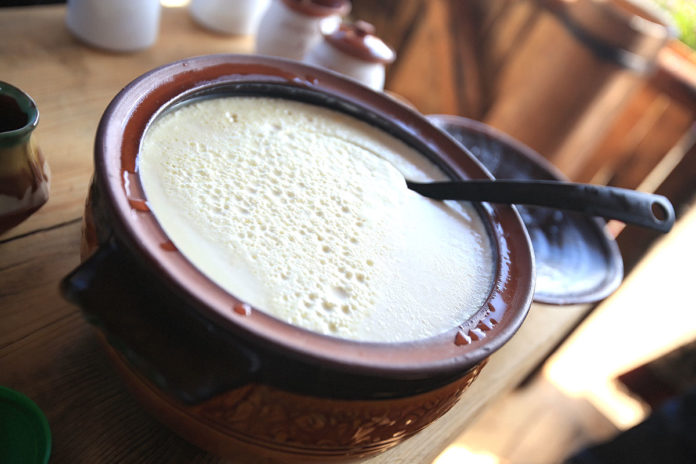Bulgarian yogurt is a fermented milk product that is derived from beneficial bacteria. Lactobacillus bulgaricus and Streptococcus thermophilus transform milk into yogurt, creating its creamy texture and distinct tang.
The Bulgarian Touch
In Bulgaria, yogurt isn’t just food; it’s heritage. Thanks to its unique bacterial strains, this dairy delight stands out globally. These microbes give Bulgarian yogurt its signature taste and confer numerous health benefits.
The two primary bacteria responsible for the unique qualities of Bulgarian yogurt are Lactobacillus bulgaricus and Streptococcus thermophilus. These bacteria work symbiotically during fermentation to transform milk into yogurt, imparting it with its characteristic taste, thickness, and health benefits. Here’s a bit more about each:
Lactobacillus Bulgaricus
- Origin: The Bulgarian scientist Stamen Grigorov first identified this bacterium in 1905. It’s native to Bulgaria’s natural environment, particularly its mountainous regions, which contributes to the unique quality of the local yogurt.
- Role in Yogurt: Lactobacillus bulgaricus is a type of lactic acid bacteria that ferments lactose (the sugar in milk) into lactic acid. This acidification process thickens the milk proteins, giving yogurt its texture and tangy flavor. It also creates an environment that benefits digestive health by promoting the growth of healthy gut flora.
- Health Benefits: Beyond its fermenting capabilities, Lactobacillus bulgaricus is recognized for its probiotic properties. It can help balance the gut microbiome, support digestion, and enhance the immune system. Some studies suggest that it may also have anti-inflammatory properties and contribute to lowering cholesterol levels.
Streptococcus Thermophilus
- Symbiosis with Lactobacillus bulgaricus: While also a lactic acid bacterium, Streptococcus thermophilus works hand in hand with Lactobacillus bulgaricus, enhancing each other’s growth and acid production. This synergistic relationship is crucial for the successful fermentation of yogurt.
- Health Benefits: Streptococcus thermophilus is beneficial for lactose intolerance as it helps break down lactose, making yogurt more digestible for individuals with lactose sensitivity. It’s also associated with various probiotic benefits, such as improving gut health and potentially reducing symptoms of certain gastrointestinal disorders.
The Symbiotic Relationship
The relationship between Lactobacillus bulgaricus and Streptococcus thermophilus is a perfect example of symbiosis. Both organisms benefit from each other’s presence, leading to a successful fermentation process. This partnership produces distinctively tangy and creamy yogurt and increases the concentration of beneficial probiotics.
These specific strains of bacteria make Bulgarian yogurt renowned for its quality and health benefits. Their ability to thrive in Bulgaria’s unique climatic conditions, combined with traditional yogurt-making practices, has made Bulgarian yogurt a product of national pride and global recognition.
Beyond the Spoon
Yogurt pairs wonderfully with various foods. Fresh fruits and a drizzle of honey and chestnuts make it a decadent dessert. Mixed with cereals and nuts, it becomes a power-packed breakfast.
Bulgarian Dishes Featuring Yogurt
- Tarator: Tarator is a cold cucumber soup made with yogurt, cucumbers, dill, garlic, water, and sometimes walnuts. It’s trendy in the summer as a refreshing dish.
- Snezhanka (Snow White Salad): Similar to tarator but thicker and served as a dip or salad, Snezhanka is made with yogurt, cucumbers, garlic, dill, and often walnuts. It’s sometimes referred to as a Bulgarian tzatziki.
- Banitsa with Yogurt: While traditional Banitsa is made with filo pastry and cheese, there are versions where yogurt is added to the filling, giving it a moist and creamy texture.
- Yogurt with Kavarma: Kavarma is a traditional Bulgarian stew made with meat (usually pork or chicken), vegetables, and spices. It can be served with Bulgarian yogurt to balance the dish’s richness.
- Moussaka with Yogurt Topping: The Bulgarian version of moussaka often features a topping that includes yogurt mixed with eggs and sometimes feta cheese, baked until golden.
- Yogurt with Baked Pastries: Bulgarian yogurt can be served alongside or used in the dough of various baked goods, such as breads and pastries, adding moisture and a slight tanginess.
Foods Eaten with Yogurt
- Fresh Fruits and Honey: Yogurt is often served with fresh fruits such as strawberries, blueberries, or peaches and drizzled with honey, making it a refreshing and healthy dessert or breakfast option.
- Cereals and Nuts: Adding yogurt to cereals, whether homemade muesli or granola, along with nuts like walnuts or almonds, creates a nutritious meal.
With its rich culture and unparalleled taste, Bulgarian yogurt remains a testament to Bulgaria’s culinary excellence. It’s not just a food item; it’s a cultural icon beloved by gourmands worldwide.



